Have you ever used a 5E model lesson to teach science? Did you know you can use it in math too? In this post, I share how to create a 5E model math lesson and use it to increase student engagement.
I LOVE teaching science! (Yes, you read that correctly.)
In fact, there were times when I loved teaching science more than math– yes, that’s right.
I enjoy doing science experiments, demonstrations, and activities with kids.
From watching liquids “layer” on top of each other and watching graham cracker “plates” converge to form volcanoes to watching the spinning of a pencil with a styrofoam Earth mimic the seasons– teaching science is just fun and the kids love it!
After my first year of teaching science via the textbook (#boring), I decided I was going all in and learning everything I could about teaching science through hands-on learning and real-world experiences.
Do you remember the scene in Jurassic Park where John Hammond, the creator of Jurassic Park, detailed how they were able to find 100 million-year old dinosaur DNA?
This clip was a great way to introduce the concept of amber. (But, as exciting as it is to use this movie to talk about fossils, be careful to only share this scene– I forgot about that cuss word that happened just before this. Oops!)
Why do I love teaching science so much?
Because of the engagement. My students love science because they are engaged in it, “playing” with big, hard-to-understand science concepts every day.
So, what about math?
I wondered, if I could get kids this excited about science, how could I get them this excited about math?
When I first started teaching, I used the textbook to teach math . . . a lot.
I’ll admit, I didn’t know how to do things differently.
But, after I started using the 5E model lesson plan to teach science, I wondered how I could connect it to math.
I dug into the work and designed a 5E model lesson plan for math that was robust and exciting and gave me a chance to design math instruction like never before. Side Note: I looked far and wide for opportunities to show Jurassic Park clips in math (#bestmoviefranchiseever), but there just didn’t seem to be a good connection.
In all seriousness, it took some time, years actually, to perfect my model, but I did it!
And my students started liking math as much as they liked science. Score!
No joke, I was on my way to being a full-time science teacher. But using the 5E model lesson renewed my excitement for teaching math.
What is the 5E Model? That’s a great question! The 5E model of instruction is rooted in the constructivist theory of learning. Students “construct” new knowledge based on their prior knowledge and experiences.
But take note, the word “construct” is an action, a verb. Students have to be engaged in something to construct new knowledge.
In fact, the 5E Model was designed to increase student engagement in . . . drum roll please . . . science.
So how do we use the 5E model to teach math?
How to Create a 5E Model Math Lesson
What I love most about the 5E model math lesson is that it allows my students an opportunity to explore, play, and discover the new content on their own before I provide any instruction or strategies.
In fact, it’s like giving students a chance to explore with a new manipulative before using it in a lesson. (By the way, this is a genius classroom management strategy. It will keep your students from playing with the manipulatives during the lesson.) Students always come up with ways to use the manipulatives I never dreamed of because they are constructing their own meaning with the tools.
The 5E model math lesson also allows me the opportunity to facilitate my lesson through questioning and assess the students’ understanding throughout the lesson via observations as students build knowledge.
Here’s how I plan my math lessons using the 5E model math lesson plan format.
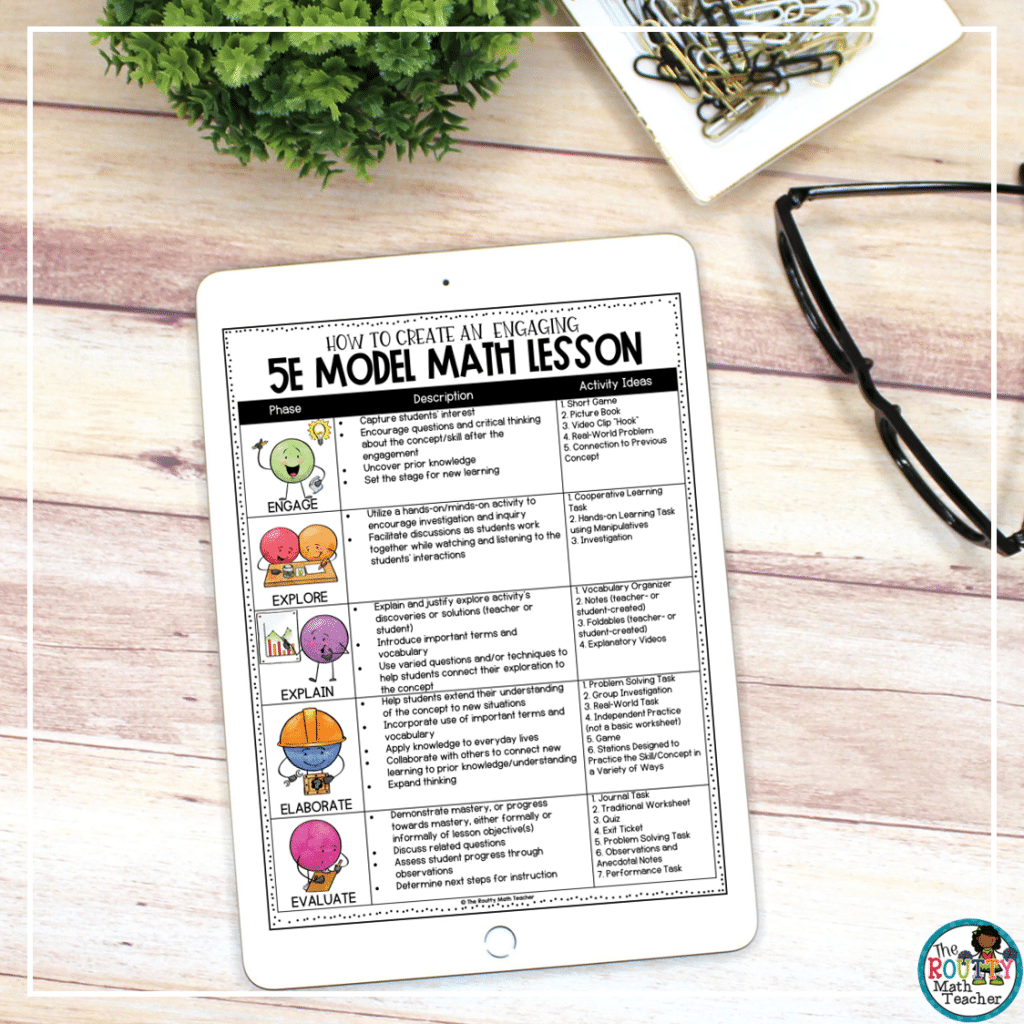
Engage
This is my favorite part of the process! It’s when I have the best opportunity to hook my students into the lesson. During this time, I may use a game, read a picture book, share a video clip, introduce a real-world problem, or initiate a notice and wonder math talk to engage my students. Note: I do not give anything away during this time, it’s just a teaser for the lesson!
Read more about engagement strategies to “hook” your students here!
Explore
After I gain the students’ attention, I provide a learning experience to help students make sense of a concept. My favorite way to do this is to give students a cooperative learning task that allows me a chance to facilitate the experience by asking questions and guiding learning.
This part of the lesson is also a time where I may provide a hands-on lesson and recording sheet for students to work through to help them make sense of the concept or skill.
Explain
There are several ways to conduct this part of the lesson:
- Teacher-Led: This is where I help students connect learning. We also complete some sort of interactive notebook activity so students have a record of their learning. When I am really crafty, I can use the interactive notebook page as an explore activity. Then we use the recording sheet to analyze and discuss further. Videos and short presentations help to make this time more meaningful and learning concrete for students.
- Student-Led: I’ve blogged before about a misconception I had with this component of the process. I thought that this was my time to take over the lesson and be the center of attention–my chance to tell the students everything about the concept. I have since learned this is an opportunity for the students to explain what they’ve learned about the concept too. My job, then, is to guide students’ thinking and help them continue to refine their understanding of the skill. Used in this way, students create artifacts, like posters or videos, to document their understanding.
Elaborate
This part of the 5E model math lesson is fun! It often includes a cooperative learning experience, game, problem-solving or real-world application task, concept-focused station rotation, or non-paper-and-pencil independent practice.
Designed to extend student thinking, the elaborate activity provides another opportunity for students to make sense of the concept or skill and refine their understanding of it.
Evaluate
This last component is my opportunity to formatively assess my students. My favorite way to do this is through a journal task because it provides me with the greatest depth of student understanding.
However, an exit task may come in handy here as well. This is also part of the lesson when I may use a quiz or a worksheet to assess student understanding. The most important thing here is to use the task to develop the best picture of where students are in the learning process so that I know how to move forward with my instruction.
Final Thoughts
The 5-E model lesson has become my favorite lesson format for my students because it provides lots of opportunities for math talk and allows students the opportunity to construct their own understanding of a concept. It also takes the focus off of me and makes student learning front and center.
Get Started with Your 5E Model Math Lesson
Ready to get started? Grab a free copy of my 5E model math lesson plan template here or using the form below.
Note: Occasionally, I have found it necessary to take more than one day to complete a lesson cycle. This creates panic for some, but the use of the additional time is beneficial as I sometimes need to complete several Explore and Explain cycles before getting to the Elaboration stage.
Sound Off!
What’s your favorite part of the 5-E planning process? Respond in the comments below.
Credits:
Mockups courtesy of Coffee Beans and Children’s Dreams
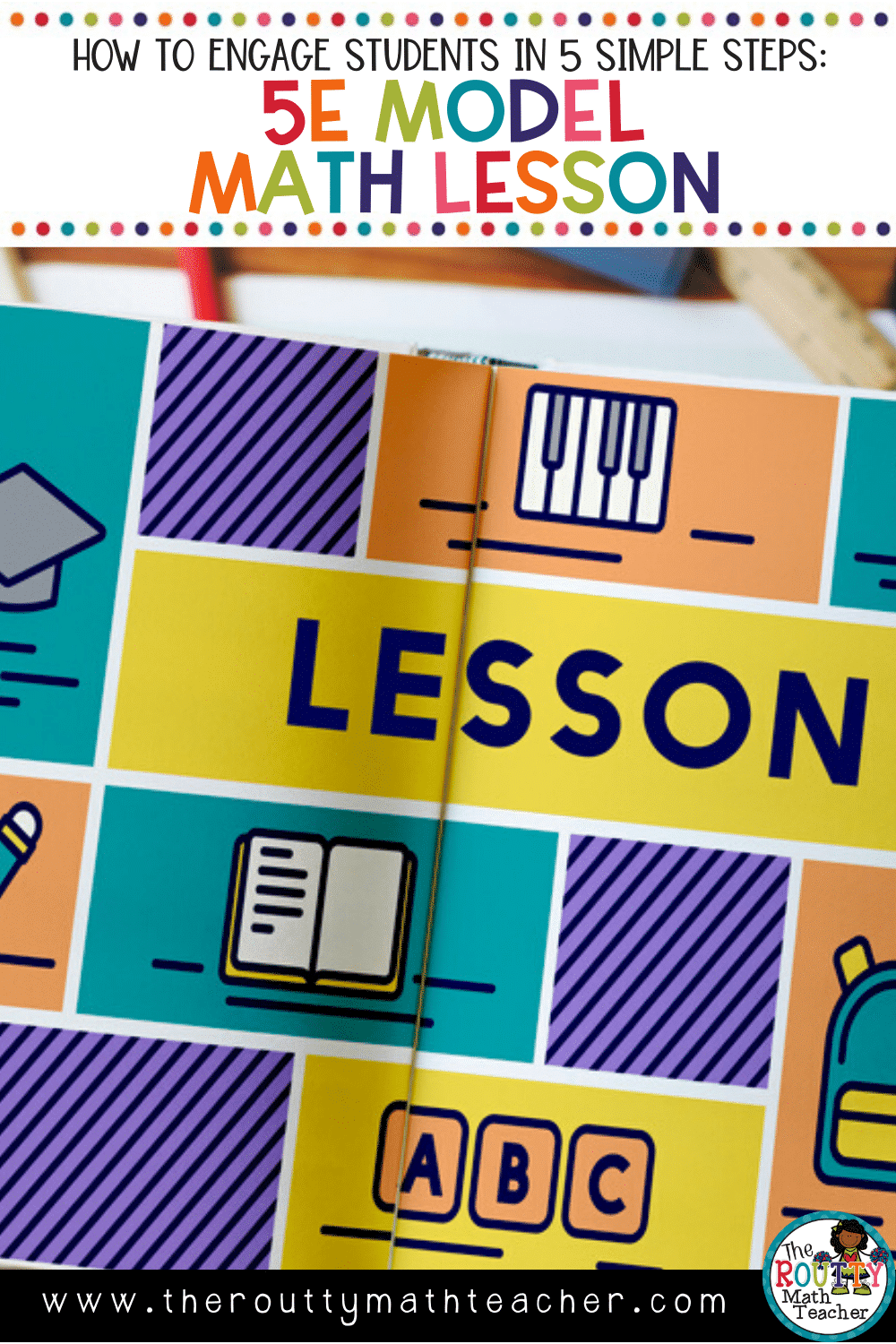
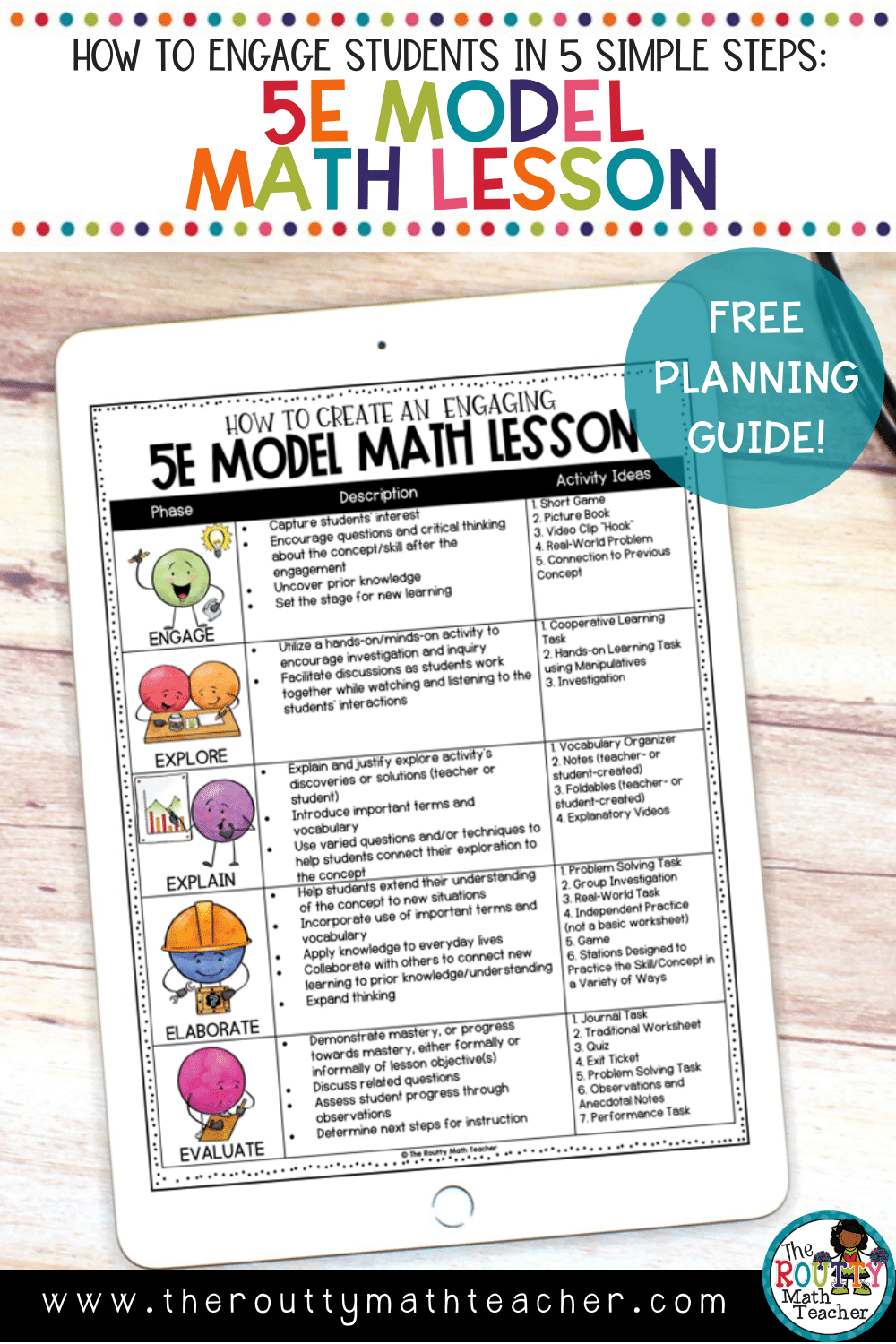






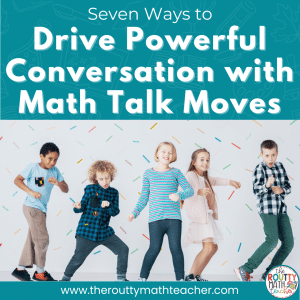
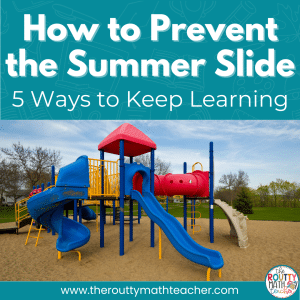
33 Responses
I was looking for something to guide me and this is what I needed. I continue to fall in love with this site. Thank you
Oh! Thank you! I’m so glad that you find the site useful!
I’m so glad I found your website. I was looking for The 5 E model examples in the images and I saw yours. Will continue to explore your site.
So glad you found the website useful! Please let me know if there is something specific you need.
I love the way the parts of the lesson are broken down. I also like that you do not have to tackle all 5 parts of the lesson in 1 or 2 days.
Thanks!
Hi Yolanda! Yes, it’s a very versatile method that allows lots of flexibility. It’s a great teaching format!
Hello! I just finished learning about the 5E model for science instruction and I am looking forward to incorporating it into my math instruction this upcoming year. Your outline for how this looks for you is very helpful! I’d love the outline, but I’m not sure where the form is?
Hi Delany! You can use the form at the bottom of the page or go to https://the-routty-math-teacher.ck.page/5e-model-math-lesson-plan-guide. Feel free to email me at [email protected] if you have any trouble. Thank you!
Shametria
Love this approach!!
Hi Cindi! I’m so glad to hear you like this approach! I love it too!
I love how the 5 E is broken down.
Hi Angela! Thank you! This is a super simple structure to use once you get used to it.
Thank you!
It’s my pleasure! Please let me know if you have any questions!
Shametria
I did not see where to get the 5E model lesson plan
Hi Danny! Sorry about that. It looks like I am having some trouble with my forms connecting to my new website. I will look into that ASAP. You can find the planning guide at https://the-routty-math-teacher.ck.page/5e-model-math-lesson-plan-guide. Thank you!
Shametria
Hi there,
Where did you get the animations on the template? So cute!
Thanks!
Hi Lauren! I got the clipart from Sarah Pecorino at https://www.teacherspayteachers.com/Store/Sarah-Pecorino-Illustration/Category/-Dot-Dudes-282234. Enjoy!
Shametria
I just came across this post while trying to plan a 5E math lesson for kindergarten. What a great post!!! I planned my lesson by following these steps and it’s going to be AMAZING! Thank you!
I’m so glad you found the information helpful! I would love to hear how it goes. Feel free to email me at [email protected].
~ Shametria
Hello, I use the 5E for my science and I love it, so I am excited to use it for math and I love how you broke it down. I did download the lesson plan guide, but was wondering if you have this lesson plan but blank so I can fill it in with the plans. I love the layout and the images 🙂
Hi Leanne! I’m so glad you love the 5E Model Lesson Plan! It’s not currently available as a blank template, but I will certainly consider this as a future update. Thank you!
~ Shametria
Hi do you have the science 5 e example set up like this
Hi Mary!
I don’t currently have a science model set up like this; however, you could use the math model to help you determine what your science plan would look like. Thank you!
~ Shametria
very nice, I personally like explore and explain part equally.
Hello!
I agree. They are both equally important for helping students make the connections they need to make when learning a new skill.
~ Shametria
Thanks for your simple but detailed information on the 5-E model Well done!
I’m so glad you found the 5E Model guide helpful, Pamela!
~ Shametria
I wanted observation of lesson plan
my favorite part is Engage because I love my students doing / engaging the activity .
Hi Beth!
Engage is my favorite part of the 5E Model, too! I try to have fun with it and really grab the students’ attention.
Shametria
I’m currently in grad school seeking a masters in C&I for math. We are learning more about the 5E Learning Cycle. So many articles and websites are about using it in science. I keep coming back to your site to see how to use it in math.
Thank you,
Leann
Hi Leann!
Love hearing that! Thank you for sharing.
Shametria